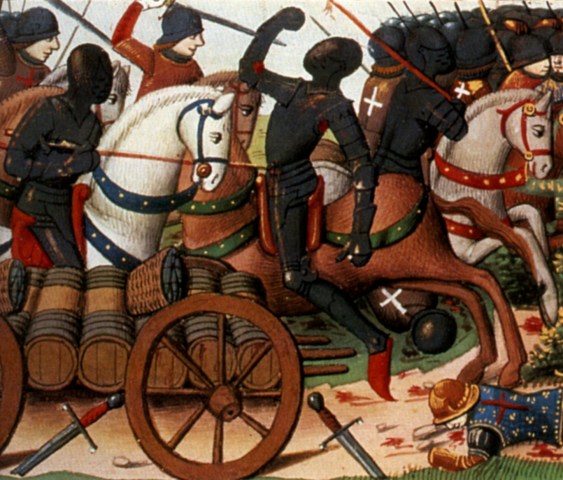History of the Stewarts | Battles and Historic Events
If you are a Stewart Society Member please login above to view all of the items in this section. If you want general information on how to research your ancestors and some helpful links - please look in background information.
If you have a specific question you can contact our archivist.
The Battle of the Herrings
12 February 1429

Journée des Harengs (From Les Vigiles de Charles VII by Martial d'Auvergne, written c.1477-84, held by Bibliothèque Nationale, Paris.)
The supply convoy was led by Sir John Fastolf and had been outfitted in Paris, where it had left some time earlier. This convoy consisted of some 300 carts and wagons, carrying crossbow shafts, cannons and cannonballs but also barrels of herrings, particularly important as Lent was approaching, a time when it was forbidden to eat meat
The battle took place on a flat, practically featureless plain. The French army, numbering between 3000 and 4000, confronted the much smaller English force who had set up defensive positions by drawing up the supply wagons into a makeshift fortification. The entire defensive formation was further protected by the placement of sharpened spikes all around to prevent the French cavalry from charging, a tactic which had been employed, with great success, at the Battle of Agincourt. The French attack began with a bombardment using gunpowder artillery, a relatively new weapon for the time and one whose use was not well understood.
The 400-strong Scottish infantry, contrary to the orders of the Count of Clermont went on the attack against the English formation. This,forced the premature ending of the artillery bombardment for fear of striking their own forces. The Scots were not well protected by armour and great damage was inflicted on them by the English archers and crossbowmen who were shooting from behind the protection of their wagon fort.
At this point, the English, seeing that the remaining French forces were slow to join the Scots in the attack decided to go on a counterattack. They struck the rear and flanks of the disorganized French/Scottish forces and put them to flight. According to contemporary accounts the French/Scots army lost about 400 men including Sir John. Among the wounded was Jean de Dunois, known also as the Bastard of Orléans, who barely escaped with his life and who would later play such a crucial role, along with Joan of Arc, in the lifting of the siege of Orléans and the French Loire campaign which followed.

